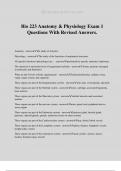©THEBRIGHTSTARS 2024
Bio 223 Anatomy & Physiology Exam 1
Questions With Revised Answers.
Anatomy - answer✔✔The study of structure.
Physiology - answer✔✔The study of the functions of anatomical structures.
All specific functions (physiology) are... - answer✔✔performed by specific structures (anatomy).
The chemical or molecular level of organizaton includes - answer✔✔Atoms, proteins (arranged
in molecules and filaments)
What are the 6 levels of body organization? - answer✔✔Chemical/molecular, cellular, tissue,
organ, organ system, and organism.
These organs are part of the Integumentary system - answer✔✔skin, hair, sweat glands, and nails
These organs are part of the Skeletal system - answer✔✔bones, cartilage, associated ligaments,
bone marrow
These organs are part of the Muscular system - answer✔✔skeletal muscles and associated
tendons
These organs are part of the nervous system - answer✔✔brain, spinal cord, peripheral nerves,
sense organs
These organs are part of the Endocrine system - answer✔✔pituitary gland, thyroid gland,
pancreas, adrenal glands, gonads, endocrine tissues in other systems
These organs are part of the Cardiovascular system - answer✔✔hear, blood, blood vessels
These organs are part of the Lymphatic system - answer✔✔spleen, thymus, lymphatic vessels,
lymph nodes, tonsils
These organs are part of the respiratory system - answer✔✔nasal cavities, sinuses, larynx,
trachea, bronchi, lungs, alveoli
, ©THEBRIGHTSTARS 2024
These organs are part of the Digestive system - answer✔✔Teeth, tongue, pharynx, esophagus,
stomach, small and large intestine, liver, gallbladder, pancreas
These organs are part of the Urinary system - answer✔✔kidneys, ureters, urinary bladder,
urethra
These organs are part of the Male reproductive system - answer✔✔testes, epididymides, ductus
deferentia, seminal vesicles, prostate gland, penis, scrotum
These organs are part of the Female reproductive system - answer✔✔ovaries, uterine tubes,
uterus, vagina, labia, clitoris, mammary glands
3 functions of the integumentary system - answer✔✔protect against environment,
regulate body temperature,
provide sensory info
3 functions of the skeletal system - answer✔✔support and protect other tissues,
store calcium and other minerals,
forms blood cells
3 functions of the muscular system - answer✔✔provide movement,
provide protection and support for other tissues,
generate heat to maintain body temperature
3 functions of the nervous system - answer✔✔direct immediate responses to stimuli,
coordinate activities of other organ systems,
provide and interpret sensory info
3 functions of the endocrine system - answer✔✔direct long-term changes in activities of other
organ systems,
adjust metabolic activity and energy used by the body,
controls structural and functional changes during development
2 functions of the cardiovascular system - answer✔✔distribute blood, water, dissolved materials,
distribute heat
2 functions of the lymphatic system - answer✔✔defend against infection and disease,
, ©THEBRIGHTSTARS 2024
return tissue fluids to the bloodstream
4 functions of the respiratory system - answer✔✔deliver air to the alveoli,
transfer oxygen to the bloodstream,
remove carbon dioxide from the bloodstream,
produce sounds for communication
4 functions of the digestive system - answer✔✔process and digest food,
absorb and conserve water,
absorb nutrients,
store energy reserves
4 functions of the urinary system - answer✔✔excrete waste from the blood,
control water balance,
store urine prior to elimination,
regulate blood ion concentration and pH
2 functions of the male reproductive system - answer✔✔produce sperm, suspending fluids, and
hormones,
sexual intercourse
4 functions of the female reproductive system - answer✔✔produce oocytes, and hormones,
support a developing embryo until delivery,
provide milk to a newborn,
sexual intercourse
Homeostasis - answer✔✔all systems working together to maintain a stable internal environment,
or maintain a 'set point'
Goldilocks principle - answer✔✔a way of describing how everything must be 'just right' in
homeostasis
2 mechanisms of Homeostatic regulation - answer✔✔autoregulation and extrinsic regulation
autoregulation - answer✔✔Also known as intrinsic regulation.
An automatic response in a cell, tissue, or organ to environmental change.




